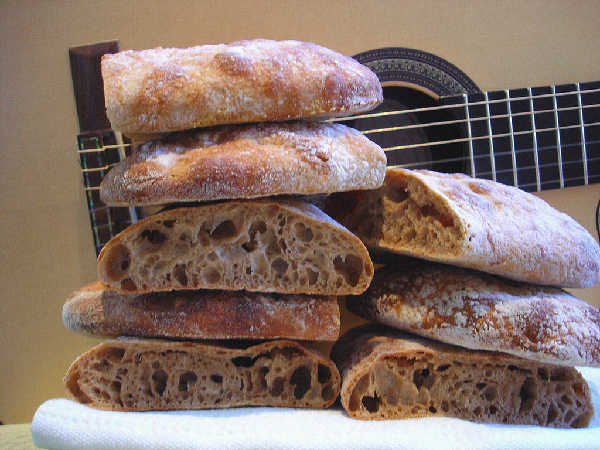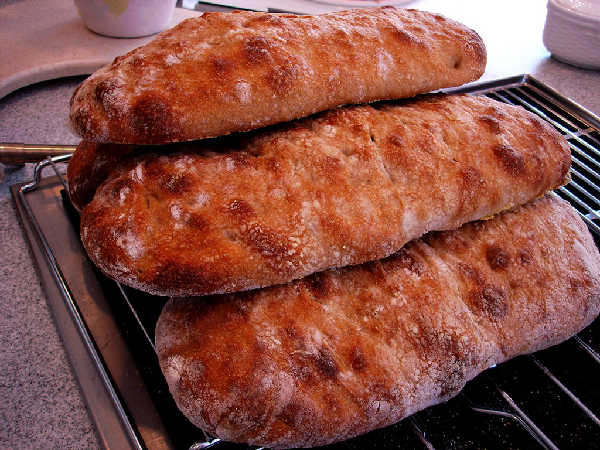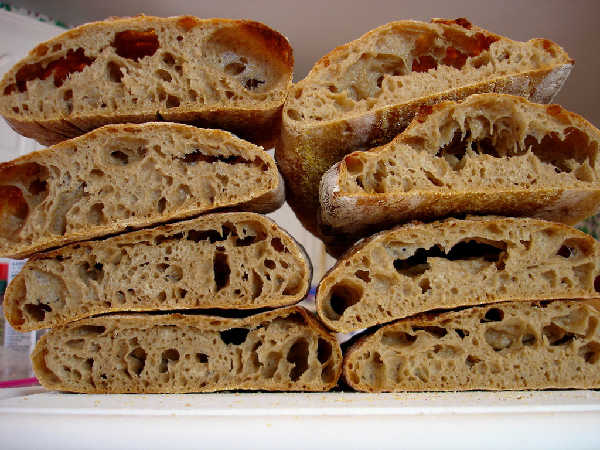Sourdough Ciabatta - One Step
 Sourdough Ciabatta - One Step (1)
Sourdough Ciabatta - One Step (1)
 Sourdough Ciabatta - One Step (2)
Sourdough Ciabatta - One Step (2)
 Sourdough Ciabatta - One Step (3)
Sourdough Ciabatta - One Step (3)
Sourdough Ciabatta - One Step Recipe
I made my first attempt at a "one step" recipe, similar to Sourdough-guy's recent blog entry (thanks, SD-guy). Photos of the process are posted. A spreadsheet showing the quantities in ounces and grams, bakers percentages, and some other percentages, such as hydration is also posted.
I wanted to use some more of my "sifted flours" obtained during a recent phase of obtaining and testing some "sifted whole wheat" flours for the fun of it. You can create a substitute for this flour by substituting a mixture of 87% white flour with 10% whole wheat and 3% wheat germ by weight. If you don't want to use wheat germ, you might try something like a 50/50 mix of white flour and whole wheat flour. I haven't tried doing it with all whole wheat, but I suspect that would also make something good with this recipe. The "sifted whole wheat flour" I used is "Golden Buffalo" from Heartland Mills. It is described as sifted so that the germ and 10% of the bran remains in the flour, which makes it about 87% extraction flour. It's characteristics are much closer to whole grain flour than white flour. For example, it absorbs a lot more water before it becomes slack like a ciabatta dough, and it has fairly high ash content and and protein percentage, and it results in a darker crumb and nuttier tasting crumb. Also, it is a high protein flour to begin with, as it is made from a higher protein wheat. At some point, I'll make this with something like KA organic AP, which should rise better and have a softer crumb and a more typical white ciabatta crust color.
Overall, this recipe worked fine, although I realize now that I probably needed to be a little more agressive about rolling and tightening the loaves when they were shaped, as there was the "big hole down the middle" problem to some extent with these loaves, particularly the ones I shaped more gently and baked first. The ones I let proof a little longer also happen to be the ones I shaped a little more tightly, and they seemed to come out better.
Ingredients:
- 57 grams 100% hydration white flour starter (almost any reasonably active, recently enough refreshed starter will do)
- 2 grams diastatic malted barley flour
- 14 grams salt
- 665 grams water
- 57 grams light rye flour (I used KA rye blend)
- 610 grams high extraction wheat flour (I used Golden Buffalo from Heartland Mills - You can mix some AP or bread flour w/whole wheat and wheat germ as mentioned above)
Mix and Rest
Place starter in a large mixing bowl and add the water. You may want to mix only 540 grams of water to begin with, which is 82% hydration. Then, after you've added all the flour, you can mix in more water until you get the right consistency. The water absorption properties of flours varies over a large range, and the amount of water I used in this recipe is at the very high end of what you're likely to need, due to the type of flour I happen to be using. Stir the water and starter well to get the starter dissolved into the water. Add the diastatic malted barley flour and mix well again. Add the rest of the flour and mix just enough to blend everything with a spoon, dough hook, scraper, as you like. Or, do this all in a mixer but use low speed and mix for only 3-4 minutes just to get the ingredients well integrated. Then add the salt, sprinkling it over the whole dough and folding it in. At this point go around the bowl with your tool scraping the outside of the mass into the center and pushing down, similar to a fold, a few times to incorporate some air and mix the ingredients with the salt well. You don't need to do much more than get the ingredients reasonably well mixed.
You may need to add either flour or water to adjust the consistency of the dough. The dough should be fairly wet. It should be more stiff than a batter, but it should feel wet and pliable. It will feel a little wetter as the water incorporates into the flour. At some point the gluten will develop, and it should become an elastic, somewhat slack, pliable dough. In my case, I am using 100% hydration, which is higher than you're likely to need unless you are using a high protein hard whole grain flour, like a hard spring wheat from the northern plains. The flour used in this recipe is of that type, except it has 90% of the bran sifted out. It takes a lot more water than if you make this with mostly white flour. So, you have to do this by feel. What should happen is that when you eventually pour this dough out on the counter to fold it, it should spread out slowly over the course of a minute or so. It shouldn't be runny, but it shouldn't hold it's shape well either.
Cover the bowl with a moist towel and set aside for an hour.
Fold in the Bowl
The first fold probably needs to be done in the bowl, if it is as wet as it is supposed to be. Reach under the dough with a scraper on an edge, lift it up and out a little holding the top gently with your (wetted) fingers, stretching it just a little, then fold the edge over to the center. Do this for all four sides. Let it sit another hour or so.
Fold on counter
An hour after the first fold in the bowl, the gluten should be forming enough to do the folds on the counter. Gently loosen the dough from the bowl and pour it out onto the counter on a light bed of flour. Spread the dough out a little if it doesn't spread out all on its own. If it is very wet, it may not need any help spreading. If it's not quite so wet, you can encourage it to spread out with your fingers or palms. Don't stretch it aggressively, just spread it out, which it should readily do if it is wet enough. Wet your hands well to get all stickiness off them and shake off the drops a little bit. Snuggle your hands under one edge of the dough and gently lift it up and out slightly. Then fold it over to the center or past the center somewhat. Do this for all four sides. If it ends up as a nice tall cube shape, pick it up and turn it over. Then drop it into a dough rising bucket or a bowl for further fermentation. To make it easier to pull out of the dough rising bucket the next time, you can either spray the bucket with some oil spray or give the dough a good dusting with bread flour on the sides before dropping it into the bucket. I often get a rectangular shape after the last fold, since I'm still not anticipating the size of the folds perfectly. If so, you can fold it over itself one more time to make it more of a cube shape and roll it over to bring the stretched side of the dough on top all in one move to end up with a tall cube of dough. Then it can be picked up from the sides or slightly underneath and lowered gently into a rising bucket.
Wait an hour and fold, wait another hour and fold, etc., as above until it begins to have some "resistance" to folding. The gluten will develop all on its own with time and some folding. In my case I did 3 folds on the counter. Ideally, you can wait as long as it takes for the dough to flatten out, as a liquid would, before folding. That's the indication the dough has "relaxed" and is ready for another fold. After a few folds, the combination of gluten developing and enough time going by for the fermentation to start to generate some gas will result in a slight "crown" forming in the dough as it sits in the bucket, so that the dough won't really flatten out anymore. You can try folding again and should now begin to be more elastic and resistant to folding, consistent with the gluten development.
Bulk Fermentation
I intended to have the total rise time be about 12 hours, and I guessed the amount of starter accordingly. I started the mixing a few hours before I went to bed. It did double in about another 7 hours after the last fold, allowing for a good night's sleep if you're a bit of a night owl like me. You can adjust the time to your convenience by putting less starter in at the beginning. I would think it would take about 2-3 more hours for each halving of the amount of starter, but maybe Sourdough-guy can put a finer point on that. The one step method is new to me, so I still haven't developed a good feel for the timing over extended periods with a very small percentage of starter in the dough.
Shaping
When the dough has doubled, turn it out on the counter in a bed of flour. It will be full of air and very soft and slack. Fold it over itself once to get a long rectangular dough. That one fold will stiffen the dough a little. Gently slice the dough into four equal size pieces. Dust the cut ends with flour or roll the pieces in flour. Lay the pieces out in rectangles about 10 inches long and 4 inches wide by gently stretching them in one direction. Roll them up fairly tightly along the short end, occasionally folding the ends of the roll into the center if it is getting too long as you roll it up. Dust them well with flour and place them in a dusted couche. You may want to use some rice flour mixed with bread flour to dust the couche. The dough is very wet and will be sticky. However, if you dust the dough itself well, and also dust the couche with a combination of rice and bread flour it should be OK. I use 25/75 rice/bread flour to dust the couche. I spray the tops of the loaves with some oil and dust with some flour in order to get that ciabatta flour streak crust look.
Final Proof
Cover the loaves with a towel and allow to rise at room temperature for about 1.5-2 hours. I didn't try getting them warmer, like 80-85F as in Sourdough-guys recipe. Also, I am not sure how long the final proof ought to run, and the poke test is harder to read with this higher hydration dough. The longer proofed, slightly more tensioned loaves had a better crumb and rise, so maybe I didn't let the proof run long enough.
Sourdough-guy suggested an estimate of more like 4 hours for the final proof in his recipe from which I derived the recipe in this blog entry, so it may well be I have underestimated the right length for the final proof. I will try a longer proof next time, and if someone tries this recipe and goes for a longer final proof with good results, I would appreciate your comments.
Bake
Place the loaves on a parchment dusted with corn meal or other similar flour to avoid sticking. As you place them on the parchment stretch them out to about 10 inches long. Then use your fingers to press down firmly all over the dough to dimple it and spread it out. I lightly sprayed the loaves with water using an atomizer pump spray bottle. You should have about a 10 inch by 5 inch rectangle when you're done with lots of dimples on it and only about 1/2 inch tall. Bake at 450F for about 18 minutes. I think the crust color darkening is the best indication of doneness, as it seems like the internal temperature isn't a very good indication of doneness for this very wet, airy, flat dough. These only rose to about 1.5 inches. I'm not sure if this is due to my flour choice or the amount of proofing. I suspect that any whole wheat-like flour may tend not to rise quite as much as a similar white flour version. However, it may also have to do with finding the right amount of time for the final proof.
Cool
Allow to cool completely. The crumb will not set properly if you cut into it too soon.
Results
The crumb was soft, cool, and creamy, and the flavor was mild with a nice after taste and only a touch of sour flavor. I believe this is fairly consistent with what I've been reading in Sourdough-guy's blog on the topic of "one step" sourdough. I get fairly similar results with my two step methods of past blog entries. However, I'm realizing that my mild results are probably the result of feeding my culture frequently, i.e. before it is very, very ripe, and also from refrigerating my intermediate "recipe starters" when they have just doubled or even earlier. I also stop my bulk fermentation when the dough has just doubled. The result may therefore be similar to the one step method, since not letting each intermediate step ripen should make the whole process closer to one long slow rise from a small percentage of starter. I think the two step method can result in more sour and stronger flavors if you let the starter and "recipe starter" ferment to a riper stage before adding them to the dough.
As with most of my attempts with sourdough ciabatta, the result is a chewier crust and slightly chewier crumb than yeast raised versions I've made. Also, the rise isn't quite as dramatic. However, the flavor more than makes up for it, and I like the chewy texture most of the time. If doing a barbecue or hamburger sandwich bread, I might prefer a white flour and probably would prefer a yeast raised version such as the Glezer recipe in Artisan Baking.
Feedback
My blog entries are written with the intention to share with and learn from those who participate here. Questions and suggestions regarding the written explanations or improvements to the methods are welcome.